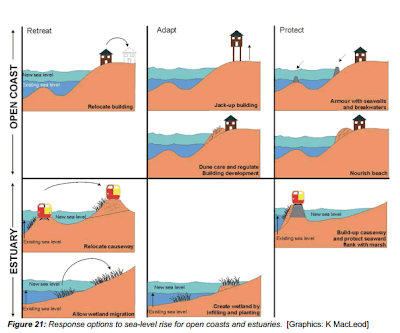WUWT has an article about how a sea wall protected Bay Head against Sandy, while neighbouring settlements were devastated. There is a new paper in the works (dated as October 2013!). You can read about it directly here from Virginia Tech. Here's a copy of the paper I found.
Not being an engineer or a coastal expert, I'll not go too deeply into the pros and cons of sea walls but note that it's not a straightforward issue. This article shows that people living adjacent to Bay Head are very concerned that Bay Head is extending the sea wall, as they believe they will be at increased risk because the sea wall will divert more water their way in future storms.
Which brings me to my question. Which sea wall did the protecting?
The press release says that the Bay Head sea wall is nearly 150 years old. Wikipedia cites the same source and says it was built in 1882. The paper itself says:
The cause of this difference lies in a forgotten historical relic. The core of the Bay Head dune was in fact a century-old, unyielding stone seawall, which had been covered over with fine to very fine dune sand by aeolian transport and beach nourishment during the twentieth century. The discovery of the relic seawall came as a surprise to many of the transient residents, and it constitutes the difficulties these transient communities have in maintaining and planning for future disasters arriving at their shores.
However other documents on the internet say a sea wall was built at Bay Head after the Great Atlantic Storm of 1962. For example, Bay Head & Mantoloking: A brief history doesn't mention a sea wall until the 1960s and states:
- Early 1960s Bay Head's sea walls are erected.
In a book: Cottages and Mansions of the Jersey Shore By Caroline Seebohm (Rutgers University Press, 2007) it says:
A north east storm in March 1962 took out most of the boardwalk, and also did serious damage to oceanfront properties. That prompted a group of prominent Bay Head residents to bring in rocks and build both a stone wall fifteen feet into the sand and a string of groins or jetties that protrude into the sea. Thanks to these groins, Bay Head now has twice as much beach as it had before 1962.
And this from nj1015.com in January 2013:
Bay Head Using Sea Walls Effectively
The professor cites the Ocean County Borough of Bay Head as an example of a municipality that has utilized sea walls effectively.
“75% of that town was protected by a sea wall that dated back to the 1962 storm and to be honest with you I didn’t even know it was there and I’m sure residents didn’t know it was there because it was buried under the sand, there was a beach in front of it and a sand dune on top of it.”
He notes during Sandy, the wall was exposed and there was evidence it protected some of the homes behind it.And another mention in this news article from December last year.
But then there is this, from an old book, Salter’s History of Monmouth and Ocean Counties:
The Bay Head Land Company was incorporated in September 6, 1879....This quickly developed Summer resort may be said to have contributed largely to the current of popular favor now bestowed upon this portion of Ocean county. It is situated at the head of Barnegat Bay, from which it takes its name "Bay Head." There are about 286 lots in this tract, 50x100 feet in size. Its present population is seventy-five. The improvements in 1882 comprise 20 new cottages, and all the other improvements in a resort in the process of development. A sea wall has been put in, roads built and graded etc.Here is a photo of damage at Bay Head from a storm in 1929. If the 1882 sea wall was in that part of town, it didn't protect all Bay Head properties. (Click to enlarge.)
 |
| Source: mantoloking.org |
So the question is, which sea wall protected Bay Head? The sea wall built in 1882 or the sea wall built in 1962? Or both? Or maybe one was built over the other? The paper doesn't mention the 1962 sea wall, so maybe that was built elsewhere? I expect the researchers knew what they were doing. Still, it's a bit of a mystery for which there is undoubtedly a very simple explanation.
Another question though: did the sea wall at Bay Head cause more damage in neighbouring unprotected coastal areas than would have occurred if the sea wall hadn't been built?
Retreat, Adapt or Protect?
And here's a nice graphic I came upon while looking into sea walls, from a chapter in a publication on the website of the Ministry for the Environment, New Zealand. It illustrates some options in response to rising seas and bigger storm surges. (Click to enlarge.)
 |
| Source: MFENZ |
The title at WUWT is "If storms are worse now, why did they need a sea wall 150 years ago?" is typical denier country. The answer, if one gives one brain cell one second to think, is in the question. There were storms 150 years ago. In my part of the world there are remains of Roman sea defences, presumably put up because the sea level was rising in the so-called Roman warm period.
ReplyDeleteBut just like Find The Lady, the title is meant to lead you away from the obvious and not think.
Yes, even though Anthony lives on the other side of the continent, you'd think that having announced the weather on television Anthony would know that there have been storms coming in from the Atlantic for quite some time :D
Delete(The sea is a bit higher now, so even if the storms weren't going to get more energetic, which they probably will, they'd still do more damage.)